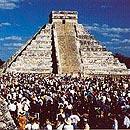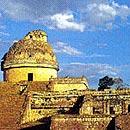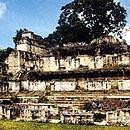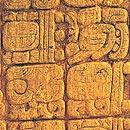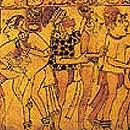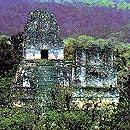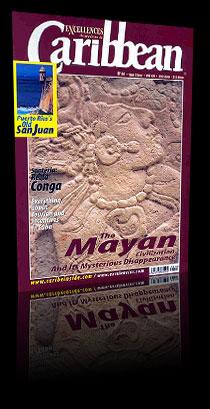The Mayan Civilization and its mysterious disappearance
Mysterious for all contemporaries, the Mayan civilization enlightened America with the legacy of modern writing, an exquisite architecture and advanced knowledge on astronomy and mathematics.
Submerged into a long and hazy dream that wafts through the depths of the jungle, the Mayan cities stand tall before the stunned eyes of those who dare walk into the giant and leafy trees just to steal a peek at a perfect urban outlay and grandiose buildings.
In the valley of the Homul River, right in the heart of Peten's exuberant vegetation (Guatemala), you hit upon Tikal, one of the ancient burgs (330 AD) with the famous 45-meter-high Temple I where the remains of king Ah Cacau rest surrounded by jewels, precious gems and carved bones.
When Spanish conquistadors reached this city in 1697, they fell on their knees as they stunningly caught sight of the Grand Pyramid, the Grand Plaza, the North Acropolis and the four temples. All of those buildings boil down to what is known as the Mayan Cradle.
The lowlands of Peten and Tikal (Guatemala) make up the core of this civilization in which the distinctive features of the Golden Age (between 633 and 830 AD) were highlighted and the main characters of that period were positioned on the pinnacle of American history.
In the city-state of Chichen-Itza, the empire's second-largest enclave, its residents pumped out the best inspiration from their ancestors and pulled the astonishing Mesoamerican culture back up in the Yucatan peninsula some 200 years after the grand civilization started retreating into the dark.
Masters of the most advanced grapheme system of all pre-Hispanic cultures and owners of the vigesimal numeric system that included number 0, Mayan priests followed the phases of the sun and the moon by means of the most accurate mathematical equations.
Helped by rustic methods and instruments still unknown, they made amazing forecasts of solar and lunar eclipses, observed the season changes, the solstices and equinoxes. They unraveled the elliptical movement of planet Venus.
Scholars believe the astronomical observations and time count made by Mayan priests were probably more accurate and closer to perfection than those in the entire contemporary world. The Chichen-Itza observatory is the proof.
Circa 755 AD, Mayan priests recorded a lunar eclipse and by the year 1050, they began predicting these phenomena that were completely unexplainable at the time, even long before Spanish king Alfonso X (The Sage) wrote his world-known books on astronomy in 1280.
Trapped inside the natural barriers, travelers can still make out –thirteen centuries later- the outline of a broad road mesh that runs through the vast territory ruled by the Mayan kings of yesteryear, as well as engineering works designed to bring water and food supplies to the population.
Underground pipelines and steam baths go hand in hand with the best wisdom and art of finesse stucco decorations. And stone steles where the most advanced calendar of the ancient world was carved.
America's tallest civil buildings, temples and pyramids gave rise to the first cities built in the territories of Mexico, Guatemala, Belize, El Salvador and Honduras in times when the Romans were watching their own empire crumble down around the 2nd century AD.
Tikal, Copan, Palenque, Bonampak, Rio Bec, Chichen Itza and Mayapan stand out from the more than 40 similar centers that bludgeoned in Yucatan (north), the central lowlands like Chiapas, the Tabasco jungles of Campeche, Guatemala, Belize and Honduras, and the southern mountains.
Unlimited splendor, rituals and human sacrifices offered to the gods; wars among rival tribes, court life, legends that lay bare the mythical origin of those peoples, and bartering trade with foreigners are carved in huge murals and stone steles that make mavens assume the importance of arts and knowledge for that long gone civilization.
Who were the Mayans? According to the most eye-to-eye positions, this human cluster gathered ethnic groups bound together in a linguistic community regardless of such well-marked cultural variants as the Huastecas, Tzetzal-Maya, Tzotzil, Choles, Quiche, Chortis and others.
With a completely unknown origin, experts assume the grandparents and parents of these groups came in successive migratory waves paddling their way from the southern territory of the United States to Mesoamerica.
Inhabitants of the southern higher grounds took the first groundbreaking steps somewhere between the years 2500 and 1500 BC to found what later became a mighty and widespread civilization. That culture shifted its cultural focus on the heart of its own cluster and managed to get in full swing during the classic period (between the 3rd and 9th centuries AD).
Then came the so-called dark centuries (from the 10th to the 16th centuries) that marked the decadence of the empire. Cities were emptied as residents rushed up to the north to find shelter in the jungle. Even after the arrivals of the Spaniards, reminiscences from the past were still quite visible.
As a sedentary people, the Mayans used the crops they grew to feed a population of more than 10 million inhabitants –one of the more densely populated spots of the planet at the time. Their diet consisted of corn, beans, chili, potatoes and cassava. They also planted sisal, cotton, flax, tomato, tobacco and avocado.
As to drinks and beverages, they preferred chocolate –a crop known in this neck of the woods for over 2,600 years. According to scholar W. Jeffrey Hurst, the Mayans used to drink chocolate with spices other than the ones we are familiar with today.
The farming of corn, a symbol of the Mesoamerican culture, singled the Mayans out from the nomads dwelling in the neighboring territories and the Caribbean. That explains why the Mayans, in their own vision of the universe, placed Chac –the god of rain, weather and grand maize- on the top of their polytheist pantheon.
They were great artisans who excelled in weaving, dying, cotton and century-plant fabrics. They were equally masters in the use of bird feathers of different colors for decorations.
Ceramic artifacts –as gorgeous in motifs and colors as sculptures- pick up stories of past dynasties and the power of city-states, as well as descriptions of the local flora, wildlife and weather conditions.
For ancient Mayans, the year and life as such used to begin when the sun crossed the zenith on July 16, stretching out for 365 days grouped in 28 weeks of 13 days each. The new year was supposed to start the same day the solar calendar marked the 365th day.
In addition, 360 days of the year used to be huddled in 18 months of 20 days each. Weeks and months were sequential and independent from one another.
Time count (tzolkin) used to happen on the same day every 260 days, a figure that can be divided by either 13 (week) and 20 (month).
Through the so-called “long count of days,” the Mayans used to carve all of the empire' major dates and celebrations in the stone steles.
Researchers believe the Mayans' time count was a whole lot more accurate and complex than those reckoned by other means prior to the coming of the Gregorian calendar in the 16th century.
The political system that ruled among the Mayans, however, never grew to be as complicated as in other parts of the world. The right explanation to that –scholars claim- lies in the fact that the Mayan elite zeroed in their powers and efforts in intellectual and artistic excellence more than in loading up on political cobwebs and red tape.
Architecture Alongside the arts and religion, Mayan architecture stands out as the only one of its kind and the most perfect style in the entire New World. Their fine decorations in bas-reliefs, paintings and carvings underscore that assertion.
The temples of Palenque, Chichen-Itza, Uxmal, Mayapan, Copan, Tikal, Uaxactun and other locations, have outlived to become the highest expression of building style and artistic expression at the time. Given their stylistic value and the themes they recreate, these were used as ceremonial centers to worship the gods and punish the slaves captured in battles against neighboring tribes.
The use of limestone mixed with cement and wood for making doors and a few windows in their houses ranked among the most outstanding features of the Mayans' civil buildings.
Stepping pyramids were covered by blocks of glazed stone and a staircase beautifully carved on one of its sides. In Mayan mythology, pyramids stand for the mountains. Climbing them means reaching out to the sky, moving beyond the earthly element and walking into the heavenly space. The forethought emphasis on height and verticality reveals the Mayans always built the pyramids pointing to the sky and to their gods. Their buildings were the tallest in the entire pre-Hispanic America.
Another architectural highlight is the famous Mayan arch or fake vault system by approximation of block rows to fill in lengthened and narrow spaces. Living colors and decorations based on sculptures and stone mosaics served to piece together other details on vertical walls. Those walls were usually bricked together and plastered with molded bases and round corners –a style widely used in temples- in order to further underscore the height impression.
The temple of Chichen-Itza is a classical case in point of how the Mayans used to unify their sense of art, science and religion, everything whittled with astonishing accuracy. The steps of the pyramid's four sides add up 364 in all, thus accounting for the year's 365 days. Likelihood is those centers were used to conduct rituals to mark the beginning of each year, as a way of reenergizing the universe and embarking on sacred journeys to heaven or to otherworldliness.
Pascal the Great, son of Zac Kuk –one of the greatest kings of Palenque who reigned from 615 to 683 AD- ordered the construction of the Temple of the Inscriptions over his grave with a magnificent bas-relief. At the same time, this pyramid treasures one of the longest hieroglyphic carvings of the whole Mesoamerican region.
The manuscripts Researchers of all stripes and places have gone about more than a century and a half of history to crack the enigma of Mayan writing. Hieroglyphics, mysterious chains of signals or combinations of them, carvings made in stone steles, dints and other architectural and decorative supporters contain jottings of major events, historic passages, kings, mythology, tragedies and rituals.
By etching those writings in stones, wood, bones, shells or vases, Mayan writing has outlived time and weather impairment combined. But it has also sown the seeds of modern man's everlasting quest toward his own meaningfulness.
Only icon-worshipping priests called ah k'ins and a handful of noblemen could decipher those shapes and letters ingrained in public places like plazas and the façades of major temples and buildings.
The well-known manuscripts of Dresdensis, Peresianus and Tro-Cortesianus –made of paper from Mexican fig tree's bark- served as calendar cards to predict and tick seasons, harvest times, weather conditions and red-letter days. The Temple of the Inscriptions, where King Pascal the Great lies in state, is a sample of the intimate linkage between the hieroglyphics and the real world, including the precise location of places and persons.
The arrival of foreigners, marriages in the royal world, ties with children and siblings, as well as the succession of Mayan dynasties, obituaries and funerals were also recorded by pen artists at the time.
Bonampak and wars As in the case of religion, tributes and manhunt of poachers, wars played a overriding role in both the formation and endurance of the Mayan state. Experts hold on tight to the assumption that the Mayans were peaceful and theocratic people, despite the readings at the Bonampak murals –dug out in 1946 and containing plenty of war scenes.
Texts and iconography depicting war themes talk about the existence of mass graves full of skulks in Colha (Belize). There, archeologists unearthed the skulks of more than 30 people who had been allegedly beheaded.
With the blood and the sacrifice of POWs, Mayan kings used to deify their power and enhance their empire, as painters and writers told.
The murals of the Temple B-XIII in Uaxactun –one of the oldest in the area, circa the 6th century- was perhaps the most important one for this civilization. And the paintings of Bonampak not only shed abundant light on traditions at the time of the late classic, but also buttress those standpoints by thoroughly reviewing countless war passages.
The murals of Bonampak, meaning the city of painted walls in Nahant tongue, were ordered by king Chaan Muan between the years 790 and 800 AD in the lands of today's Mexican state of Chiapas. By the way, they remained buried until 1946.
Mysterious disappearance Whenever we try to pry into the deepest nooks and crannies of the Mayan realm all the way to the sunset of that civilization, we suddenly find ourselves stonewalled, trapped in an almost unreachable, still, deaf and mute world that pays no heed to our begging for a clear-cut explanation about the mysterious vanishing of this former mighty empire.
The history of mankind is packed with instances of ancient towns and cities that faded out into thin air and brought on different versions about the alleged collapse. Foreign invasions, devastating plagues and natural catastrophes have carried the blame for the tragedy.
In the case of the Mayan world, experts are following leads that point to an assumed shortage of lands triggered by the intense deforestation that the slash-and-burn farming method brought about. Manmade actions to transform the environment also took a heavy toll and probably led to an ecological disaster in the Mayan territories.
By the year 900 AD, dwellers began to scram out of the city-temples. That's the conclusion of a study published by a team of U.S. researchers in September 2002.
Human interference, coupled with drought, did in water supplies in the lowlands, especially in the marshlands and lakes.
As the population grew –a tad over 10 million inhabitants comprised in an area of little more than 156,000 square miles- bad farming methodology gave way to the zone's deforestation.
The breach in the ecological balance prompted deep agricultural crises that eventually led to famine. This situation pushed residents up to the north. Under these terrible conditions, heated political melees came in no time and “the people lost faith in their rulers.” (Sylvanus G. Morley ).
Another thesis seemingly holding water is the beginning of ruinous clashes between the peasantry and the priests, mostly prodded by the lack of fertile lands, foodstuffs and continuous pressures to keep the payment of tributes in place –one of the things that kept the empire going for the longest time. (Thompson).
Nonetheless, all beaten tracks so far indicate that maybe a serious drought was to blame for giving this civilization a devastating final blow. Or perhaps a domestic war between two mighty kingdoms, as another recent thesis claims based on hieroglyphic readings, was responsible for the decay.
On the heels of the chaos that swept most of the Mayan lands, the northern side stretched out its glory days for another 20 years until the final downfall came to pass as soon as Spanish conquistadors touched down on Yucatan in 1511.
The hieroglyphics found in Dos Pilas, in the Guatemalan jungle of Peten, plus the drawings of Bonampak, seem to disclose that a war between two huge and powerful chunks of the population, such as Tikal and Calakmul, that eventually branched out into numerous lesser rifts without a final winner, probably played its part in the disappearance of the Mayan world.
Breaking the codes of the hieroglyphics provides sort of a time window to peer out at one of the oldest civilizations of the Americas, its history and a world that put up a roadblock no one ever cleared for centuries.
During its glory days, the Mayans had a population of 10 million inhabitants and made up one of the world's most developed and populated human clusters.
The Mayan elite homed in their energies on intellectual and artistic improvement, a reason why their political system never grew to be as complicated as in other civilizations.
In huge murals and stone steles, the Mayans used complex hieroglyphics to talk about religious rituals, wars, red-letter days and creeds explaining their origin.



